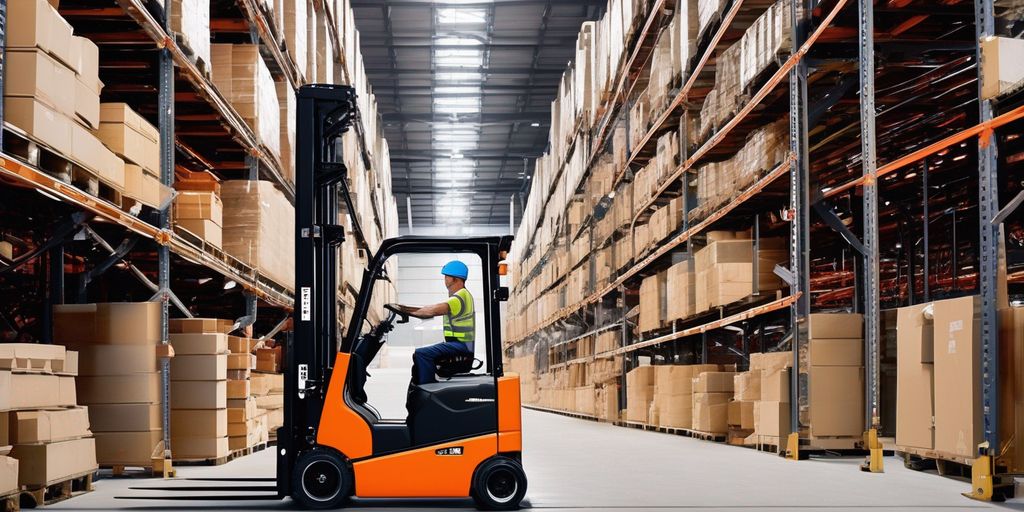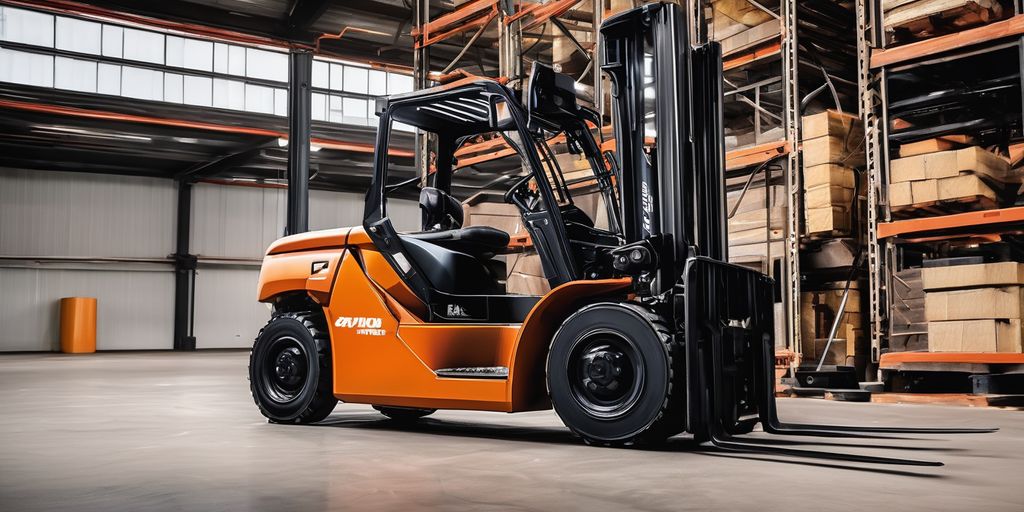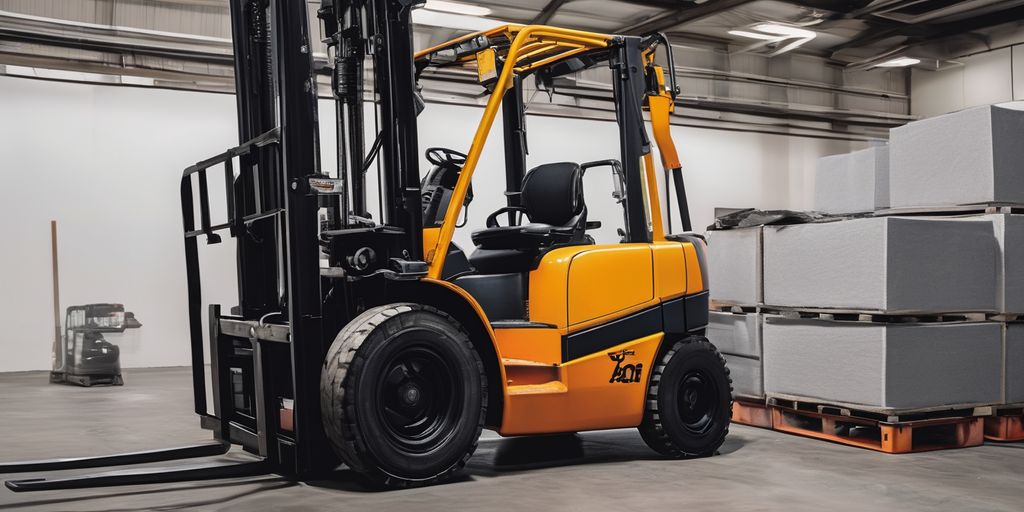Using a clamp forklift can help you move different kinds of items easily and safely. This tool is great for lifting heavy and oddly shaped objects without much risk of injury. It also lets your workers handle more items quickly, freeing them up to do other important jobs.
Key Takeaways
- Clamp forklifts make it easier and safer to move heavy and oddly shaped items.
- Different types of clamps are available for various materials and tasks.
- Choosing the right clamp depends on load type, weight, and material sensitivity.
- Using clamps can boost productivity and reduce product damage.
- Proper training and maintenance are essential for safe clamp forklift operation.
Understanding Forklift Clamp Attachments
Forklift clamp attachments are designed to extend the functionality of a forklift beyond its conventional load lifting capabilities. They equip the forklift with the ability to hold, grip, squeeze, and manipulate loads of various shapes and sizes. With a clamp forklift attachment, handling non-palletized and irregularly shaped loads becomes a breeze.
Choosing the Right Forklift Clamp for Your Needs
Assessing Load Type
Before buying a forklift clamp, it's important to know what kind of load you'll be handling. Different clamps are designed for different materials. Consulting with a professional can help you pick the right clamp for your needs.
Evaluating Weight Capacity
The clamp's weight capacity should match the forklift's capacity and the weight of the product. Remember, the clamp's weight will affect the forklift's limits. Always check these details to ensure safe operation.
Considering Material Sensitivity
Some materials are more delicate and need special care. Choose a clamp that can handle sensitive items without causing damage. This is crucial for maintaining product quality and reducing waste.
Picking the right clamp is essential for efficient and safe material handling. Make sure to consider all factors before making a decision.
Benefits of Using Forklift Clamps

Enhanced Safety
Forklift clamps are designed to handle non-palletized products carefully, reducing the risk of damage. This increases safety on the job site by ensuring that items are securely held during transport. Additionally, using clamps can minimize the need for manual handling, which lowers the risk of worker injuries.
Increased Productivity
By transforming a traditional forklift into a versatile machine, forklift clamps allow for quicker and more precise handling of materials. This enhances efficiency and reduces the time needed to complete tasks. Workers can transport more items, including heavy and uniquely shaped objects, with less effort, allowing them to focus on other essential tasks.
Reduced Product Damage
The efficient design of forklift clamps, often incorporating soft materials like cushioning, helps keep products in optimal condition during transport. This improves end-user satisfaction by avoiding damaged materials and ensuring that products arrive in perfect condition. The careful handling provided by clamps is especially beneficial for delicate or oddly shaped items.
Using the right forklift attachments can significantly improve productivity and safety in various industries, from warehousing to manufacturing.
How to Operate a Forklift with a Clamp Attachment
Operating a forklift with a clamp attachment requires careful attention to detail and adherence to safety protocols. Proper installation and operation are crucial for maximizing efficiency and ensuring safety.
Attachment Installation
- Inspect the Clamp: Before installation, check the clamp for any visible damage or wear. Ensure all parts are in good working condition.
- Secure the Attachment: Follow the manufacturer's instructions to attach the clamp securely to the forklift. Double-check all connections to ensure they are tight and secure.
- Test the Functionality: Once installed, test the clamp to make sure it opens and closes smoothly. This step is vital for preventing accidents during operation.
Operational Guidelines
- Understand the Controls: Familiarize yourself with the forklift's controls, especially those related to the clamp attachment. This includes knowing how to open, close, and adjust the clamp.
- Load Positioning: Position the load correctly within the clamp to ensure a secure grip. Misaligned loads can lead to accidents and product damage.
- Speed Management: Operate the forklift at a safe speed, especially when carrying a load. High speeds can cause instability and increase the risk of accidents.
Safety Precautions
- Regular Maintenance: Keep the clamp attachment in good condition through regular maintenance. This includes checking for wear and tear and replacing any damaged parts.
- Operator Training: Ensure all operators are trained in using the clamp attachment. Proper training includes understanding load limits and safe handling procedures.
- Monitor Load Stability: Always monitor the stability of the load during operation. Unstable loads can shift and cause accidents.
For a comprehensive guide on essential parts of a fork truck, including mast operation, common issues, forks, attachments, and safety measures for efficient operation, refer to the manufacturer's manual.
By following these guidelines, you can enhance productivity, safety, and reduce costs through proper maintenance and operator training.
Maintenance Tips for Forklift Clamp Attachments
Regular Inspections
Regularly inspect your clamp forklift attachments for any signs of wear or damage. This includes checking the hydraulic system, the padding on the clamps, and the overall structural integrity of the attachment.
Proper Cleaning
A clean operator's area enhances safety and operator efficiency. Begin by thoroughly cleaning the operator's area to remove any debris or obstructions. This simple step can prevent accidents and ensure smooth operation.
Timely Repairs
Ensure any necessary repairs are carried out promptly by a professional. Regular maintenance checks and ensuring that the forklift is in good working condition can prevent minor issues from becoming major problems.
Regular maintenance checks and ensuring that the forklift is in good working condition can prevent minor issues from becoming major problems.
Safety Tips for Using Forklift Clamps
Training for Operators
Ensure all operators are properly trained in using the specific clamp forklift attachment. This includes understanding the load limits, knowing how to handle specific types of loads, and being aware of safety procedures.
Ensuring Proper Fit
Always use the correct attachment for the job. Using the wrong attachment can not only lead to inefficiency but also pose a significant safety risk.
Monitoring Load Stability
Never overload the forklift's rated capacity. Properly secure the load to prevent shifting during transport. Regularly inspect the hydraulic system, the padding on the clamps, and the overall structural integrity of the attachment.
Conclusion
In conclusion, using a clamp forklift can greatly improve the efficiency and safety of your material handling operations. These attachments allow workers to move heavy and oddly shaped items with ease, reducing the risk of injury and freeing up your team to focus on other important tasks. By understanding the different types of clamps and their specific uses, you can choose the right attachment for your needs and get the most out of your forklift. Remember to always consider the load type, weight capacity, and material of the load when selecting a clamp attachment, and ensure your team is properly trained to use it safely. With the right clamp forklift attachment, you can enhance productivity and keep your workplace running smoothly.
Frequently Asked Questions
Can I use any clamp attachment on any forklift?
No, not all clamp attachments are compatible with every forklift. You need to check the specifications of both the forklift and the clamp to make sure they match.
How do I maintain my forklift clamp attachment?
Regular inspections, proper cleaning, and timely repairs are key to maintaining your forklift clamp attachment. Always follow the manufacturer's guidelines.
Can a forklift clamp attachment handle any type of load?
No, different clamps are designed for different types of loads. It's important to choose the right clamp based on the material and weight of the load.
Is special training required to operate a forklift with a clamp attachment?
Yes, operators should receive specific training on how to safely and efficiently use a forklift with a clamp attachment to avoid accidents and damage.
Can I use a clamp attachment to handle fragile items?
Yes, some clamp attachments are designed to handle fragile items carefully. Look for clamps with cushioning and other features that protect delicate materials.
What are the benefits of using a forklift clamp attachment?
Using a forklift clamp attachment can enhance safety, increase productivity, and reduce product damage. It allows you to handle heavy and uniquely shaped items with ease.




Leave a comment
This site is protected by hCaptcha and the hCaptcha Privacy Policy and Terms of Service apply.